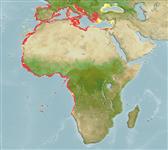Environment: milieu / climate zone / depth range / distribution range
Sinh thái học
Biển gần đáy; Mức độ sâu 30 - 400 m (Ref. 5222). Subtropical; 46°N - 18°S, 19°W - 41°E
Eastern Atlantic: Portugal to Angola, including the Mediterranean.
Bộ gần gũi / Khối lượng (Trọng lượng) / Age
Maturity: Lm ? range ? - ? cm
Max length : 164 cm TL con đực/không giới tính; (Ref. 89707); Khối lượng cực đại được công bố: 35.0 kg (Ref. 5222)
Các tia vây lưng cứng (tổng cộng): 11; Các vây lưng mềm (tổng cộng): 13-14; Tia cứng vây hậu môn 3; Tia mềm vây hậu môn: 8. Distinguished by the following characteristics: uniformly dark reddish brown or greyish violet to yellowish grey; posterior parts of median fins with distinct white edge; 2-3 dark bands radiating posteriorly from the eye, uppermost extends from the eye to the lower opercular spine, 2nd runs from the lower edge of the eye across the angle of preopercle to the juncture of interopercle and subopercle, 3rd band extends from the dark mustache streak at the upper edge of the maxilla to the lower edge of preopercle; body depth 2.7-3.0 times in SL; head length 2.3-2.5 in SL; convex interorbital area; angular preopercle, 3-5 distinctly enlarged serrae at the angle and usually slender, antrorse or ventrally directed spine on ventral edge near the angle; serrate subopercle and interopercle; distinctly convex upper edge of operculum; posterior nostril is 2 or 3 times size of anterior nostril; scaly maxilla, reaching to or beyond vertical at rear edge of eye; 2 rows of teeth in midlateral part of lower jaw, inner teeth larger; well developed canines at front of jaws; caudal fin truncate, corners slightly rounded; body scales distinctly ctenoid, with numerous auxiliary scales (Ref. 089707).
Occurs on sandy mud bottoms (Ref. 3589). Feeds on fishes and invertebrates (Ref. 5506). Maximum weight of 78 kilograms reported by Jose Manuel, Spain (05/05).
Life cycle and mating behavior
Chín muồi sinh dục | Sự tái sinh sản | Đẻ trứng | Các trứng | Sự sinh sản | Ấu trùng
Heemstra, P.C. and J.E. Randall, 1993. FAO Species Catalogue. Vol. 16. Groupers of the world (family Serranidae, subfamily Epinephelinae). An annotated and illustrated catalogue of the grouper, rockcod, hind, coral grouper and lyretail species known to date. Rome: FAO. FAO Fish. Synop. 125(16):382 p. (Ref. 5222)
IUCN Red List Status (Ref. 130435)
Threat to humans
Harmless
Human uses
Các nghề cá: Tính thương mại
Các công cụ
Special reports
Download XML
Các nguồn internet
Estimates based on models
Preferred temperature (Ref.
123201): 12.3 - 17.2, mean 14.9 °C (based on 180 cells).
Phylogenetic diversity index (Ref.
82804): PD
50 = 0.5000 [Uniqueness, from 0.5 = low to 2.0 = high].
Bayesian length-weight: a=0.01175 (0.00571 - 0.02419), b=3.04 (2.88 - 3.20), in cm total length, based on LWR estimates for this Genus-body shape (Ref.
93245).
Mức dinh dưỡng (Ref.
69278): 3.8 ±0.55 se; based on food items.
Generation time: 28.2 ( na - na) years. Estimated as median ln(3)/K based on 1
growth studies.
Thích nghi nhanh (Ref.
120179): Rất thấp, thời gian nhân đôi của chủng quần tối thiểu là hơn 14 năm (Preliminary K or Fecundity.).
Fishing Vulnerability (Ref.
59153): Very high vulnerability (87 of 100).
Nutrients (Ref.
124155): Calcium = 22.5 [8.2, 54.4] mg/100g; Iron = 0.669 [0.308, 1.587] mg/100g; Protein = 18.2 [16.5, 19.9] %; Omega3 = 0.267 [0.136, 0.540] g/100g; Selenium = 52.6 [20.4, 126.8] μg/100g; VitaminA = 19.2 [4.0, 96.1] μg/100g; Zinc = 0.745 [0.455, 1.220] mg/100g (wet weight);
